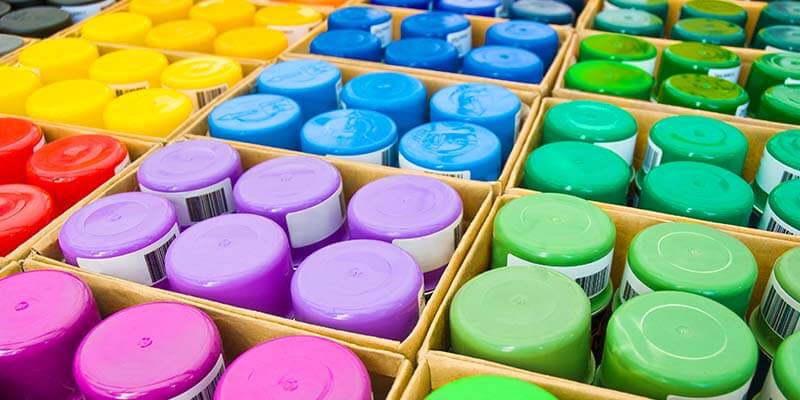Offering a more even coverage and faster application process than paintbrushes, spray painting has become an increasingly popular decorating method. Although spray painting boasts a plethora of benefits, it can be detrimental if inhaled or if it comes in contact with your skin. Therefore, in order to avoid causing any harm to you or others, it is vital that you are well informed of essential spray paint safety tips.
The ultimate guide to spray paint safety
To produce effective results when spray painting, you must safely use the correct products and equipment. If used incorrectly, spray paint can cause a number of problems and potentially become hazardous, so implementing safety precautions is an absolute must.
Before you start painting, you need to find the perfect colour for your DIY mission. Luckily, with our extensive collection of RAL colour sprays and Pantone colour aerosols you are garunteed to find the colour you desire. After you have selected the most appropriate colour, you can then utilise our useful safety methods which will keep you protected during and after the painting process.
Storing
Improper storage of your spray paints could result in the spray not working the next time you use it, may damage your property and potentially cause harm to those in close proximity. To avoid this, you should always ensure that the lid is securely attached after use as this helps keep the paint fresh and prevents the can from inadvertently triggering. In terms of where to actually store your spray paints, it’s up to you, but there a few guidelines you must adhere to. In the UK, there is a law which states you cannot supply an aerosol paint container to a person under 16 years of age. For this reason, it is vital that you keep your spray paints out of reach from young children. Ideally, aerosols should also be kept well out of the sun, in a cool dry place. If exposed to direct sunlight, the pressure inside the aerosol can increase, leading it to burst open and explode. However, try not to store the cans somewhere with significantly low temperatures as this will degrade the quality of the paint.
If you have used your spray paint and are left with an empty aerosol can, it should be removed, thrown out and, if possible, recycled. Piercing an empty aerosol can for whatever reason should be avoided at all costs as the container may still have a degree of pressure inside, as well as residues of the contents. Furthermore, it could be flammable or cause injury if the container is damaged.

Heat
Before you begin the painting process, we suggest risk assessing your spraying location. While spraying outside may seem like the ideal atmosphere as it minimises the risk of damaging your property interior, it can be problematic. As previously mentioned, aerosols do not react well with heat, so being exposed to a consistent amount of sunlight while outside could lead to the can exploding. Therefore, if you do opt to spray paint outside, we suggest going to a shaded area if possible.
On the other hand, if you are committed to spray painting inside, you should double-check that any heat sources, such as household appliances, are turned off. This includes radiators, electric heaters, stoves or electrical tools.
Masks and ventilation equipment
It is likely that the aerosol can you use will contain solvents that are harmful if inhaled. Without the right protective clothing or masks, you are more likely to be exposed to health complications such as itchy skin, throat irritation and nausea. Ceratin masks available also cover your eyes and are able to break down the gas particles which stop it from reaching you. We recommend shopping around and finding the right mask for your spray painting task as well as one that is comfortable to wear.
One of the best ways to protect yourself when spray painting is to ensure there is sufficient ventilation. If you are working outside, then ventilation is not a problem; however, if anyone is helping or overlooking the project, they should also wear a respiratory mask. For interior spray painting, you can create optimum ventilation by opening all windows or utilising air vents and fan systems.

Clothing
Although protective clothing may not be necessary for every spray painting project, we recommend getting into the habit of wearing it, especially if you plan to use spray paints frequently. For minor painting jobs, you could get away with wearing old clothes that you don’t intend to wear again, but there is no harm investing in a high-quality coverall. Combined with a respirator, a coverall will provide you with the ultimate protection while spray painting and you will not have to worry about ruining your clothes or causing skin irritation. You may also want to consider using painting gloves as they will protect your hands from being stained by the colour pigment, but also provide efficient grip to allow dexterity, control and a suitable range of movement.
Damaged cans
Before you use any of your spray paints, it is important that you inspect the can thoroughly for any visible damage. If a can is damaged, a plethora of problems could arise such as leaking, potentially exposing yourself to the chemicals within the can. Damaged cans can also cause compression, causing dangerous levels of pressure to build up within the can itself. If you find your can is damaged in any way, you should avoid using it at all costs.
Best ways to use your aerosol cans
Whether you are using British Standard aerosols or Pantone colour aerosol spray cans, the right method promises to produce high quality results. Firstly, we believe taking the time to paint your desired area in small bursts rather than long ones is beneficial. This is not only good for your health, but it also allows you to build up the colour perfectly. We also recommend doing this, especially if you are working in a confined space, as it will reduce the impact of spray can vapours.
One of the best features of aerosol spray paints is their versatility. Suitable for application on a number of materials, such as glass, wood, plastic and fabric, you can easily transform any object with a coat of spray paint. If you do not have much experience with spray painting, or think you can produce better results, you should follow our How to – Spraying Tutorial which shows you how to achieve the best colour and finish.

Spray painting safety 101
With any DIY project, safety is of utmost importance, and spray painting is no exception. We hope our suggestions make you feel more confident while spray painting and allow you to eradicate any potential harm it could cause. If you do have any questions regarding any of our paints or have any further safety concerns regarding spray painting, please do not hesitate to get in touch.





